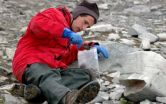(Press-News.org) PROVIDENCE, R.I. – A new study by a Rhode Island Hospital researcher has found it's possible to maintain high-quality CT colonography diagnostic images while reducing the radiation dose. This is important as the use of CT colonography, or virtual colonoscopy, becomes more widely used for colorectal cancer screenings.
Through his research, Kevin J. Chang, M.D., of the department of diagnostic imaging, found that decreasing the tube voltage would not negatively impact the integrity of the CT colongraphy. His research is published in the current issue of the journal Radiology.
"Radiation dose is a concern for many in health care – from the clinicians and patients to the government agencies that regulate the industry," Chang said. "The theoretical risks of radiation exposure as a cancer causing agent must be weighed realistically against the substantial benefits of colon cancer screening.
According to the American Cancer Society (ACS), colorectal cancer is the third most common cancer diagnosed in both men and women in the U.S. The ACS estimates that in 2013, the U.S. will see 102,480 new cases of colon cancer, and 40,340 new cases of rectal cancer. Colorectal cancers are expected to cause about 50,830 deaths during 2013.
The study was conducted to assess the effect of decreasing the radiography voltage on dose and ultimately on 3D image quality in patients undergoing CT colonography, and how these changes are affected by patient size. After studying the CT colonography results in 63 patients, the results showed a statistically significant decrease in radiation dose while only slightly decreasing 3D image quality in patients of all sizes.
Chang says that more study is needed, but that he and other experts anticipate even more decreases in CT radiation dose in the coming years.
"Colorectal cancer screenings are an important part of preventative medicine," Chang said, "and by lowering the radiation dose, we can lower patients' concerns and their exposure, while maintaining the diagnostic quality of the exam and providing early detection and treatment."
Chang's principal affiliation is Rhode Island Hospital, a member hospital of the Lifespan health system in Rhode Island. He also has an academic appointment at The Warren Alpert Medical School of Brown University, department of diagnostic imaging. Other researchers involved in the study are William W. Mayo-Smith, M.D., Dominique B. Caovan, M.D., and David Grand, M.D., of Rhode Island Hospital's department of diagnostic imaging; and Walter Huda, Ph.D., of the Medical University of South Carolina, department of radiology and radiological science.
###
About Rhode Island Hospital
Founded in 1863, Rhode Island Hospital in Providence, R.I., is a private, not-for-profit hospital and is the principal teaching hospital of The Warren Alpert Medical School of Brown University. A major trauma center for southeastern New England, the hospital is dedicated to being on the cutting edge of medicine and research. Last year, Rhode Island Hospital received more than $55 million in external research funding. It is also home to Hasbro Children's Hospital, the state's only facility dedicated to pediatric care. For more information on Rhode Island Hospital, visit http://www.rhodeislandhospital.org, follow us on Twitter @RIHospital or like us on Facebook http://www.facebook.com/rhodeislandhospitalpage.
RHODE ISLAND HOSPITAL
A Lifespan Partner
Contact: Ellen Slingsby
Twitter: @eslingsby
RI Hospital: Radiation can be reduced while maintaining high quality in CT colonography
CT colonography used to detect colorectal cancers
2013-03-12
ELSE PRESS RELEASES FROM THIS DATE:
UF study shows spiders, not birds, may drive evolution of some butterflies
2013-03-12
GAINESVILLE, Fla. --- Butterflies are among the most vibrant insects, with colorations sometimes designed to deflect predators. New University of Florida research shows some of these defenses may be driven by enemies one-tenth their size.
Since the time of Darwin 150 years ago, researchers have believed large predators like birds mainly influenced the evolution of coloration in butterflies. In the first behavioral study to directly test the defense mechanism of hairstreak butterflies, UF lepidopterist Andrei Sourakov found that the appearance of a false head – a wing ...
Scientists identify why some fathers are left holding the baby
2013-03-12
A century old mystery as to why, for some animals, it's the father rather than the mother that takes care of their young has been cracked by scientists at the University of Sheffield and University of Bath.
Researchers from the University, in collaboration with the University of Bath and Veszprém (Hungary) found that role reversal was caused by an imbalance in the numbers of males relative to females.
The findings have been published in the journal Nature Communications.
Darwin noted in 1871 that in most animals, it is the females that spend most time looking after ...
After years of growth, fewer transplants done through 'kidney chains'
2013-03-12
An additional 1,000 patients could undergo kidney transplants in the United States annually if hospitals performed more transplants using paired kidney exchanges, new Johns Hopkins research suggests.
Also known as kidney chains, paired kidney exchanges, which allow incompatible donors to give a kidney on a loved one's behalf and ensure that loved one gets a compatible kidney from a third party — usually a stranger — in return, have become much more common since 1999 when The Johns Hopkins Hospital pioneered the practice. But the dramatic growth in the use of these exchanges ...
Prediction of seasonal flu strains improves chances of universal vaccine
2013-03-12
Researchers have determined a way to predict and protect against new strains of the flu virus, in the hope of improving immunity against the disease.
Influenza is a rapidly spreading acute respiratory disease. Worldwide, annual seasonal epidemics of the flu result in 3-5 million cases of severe illness, and up to 500 000 deaths. A newly emerged virus can spread across 74 countries in 2 months.
The study led by the University of Melbourne with Monash University and international colleagues has found how to predict and potentially stop the mutating cells of the influenza ...
Antarctic and Arctic insects use different genetic mechanisms to cope with lack of water
2013-03-12
Although they live in similarly extreme ecosystems at opposite ends of the world, Antarctic insects appear to employ entirely different methods at the genetic level to cope with extremely dry conditions than their counterparts that live north of the Arctic Circle, according to National Science Foundation- (NSF) funded researchers.
Writing in the Proceedings of the National Academy of Sciences, the researchers concluded, "Polar arthropods have developed distinct... mechanisms to cope with similar desiccating conditions."
The researchers noted that aside from the significance ...
Low-cost nano-biosensor to detect foodborne pathogen that causes listeriosis
2013-03-12
New Rochelle, NY, March 12, 2013—The foodborne bacteria Listeria monocytogenes sickens about 2,500 people in the U.S. each year and many more worldwide, killing about 25-30% of those infected. Listeriosis is caused by eating food contaminated with L. monocytogenes, and current methods for detecting the bacteria are costly and time consuming. An innovative nanotechnology-based method for developing an inexpensive biosensor to detect the pathogen in food is described in Industrial Biotechnology, a peer-reviewed journal from Mary Ann Liebert Inc., publishers (http://www.liebertpub.com). ...
Repairing the nose after skin cancer in just one step
2013-03-12
ANN ARBOR, Mich. — The skin cancer growing on Carolyn Bohlmann's nose was not a very aggressive variety. But it was deep and located right on her nostril. The tricky part was not so much removing it – MOHS surgery, the procedure Bohlmann had, is a fairly common outpatient procedure.
The tricky part would be reconstructing her nostril so that it didn't lift up or droop down. It's an important cosmetic issue, but it's also critical for breathing.
Bohlmann opted for a new reconstruction technique her surgeon, Jeffrey Moyer, M.D., was offering at the University of Michigan ...
Cryptic clams: U-M biologists find species hiding in plain view
2013-03-12
ANN ARBOR— Cryptic comments seem to have an ambiguous, obscure or hidden meaning. In biology, cryptic species are outwardly indistinguishable groups whose differences are hidden inside their genes.
Two University of Michigan marine biologists have identified three cryptic species of tiny clams, long believed to be members of the same species, which have been hiding in plain view along the rocky shores of southern Australia for millions of years.
The unusual convergence of a climate-cooling event and the peculiarities of local geography caused the three cryptic species ...
Havoc in biology's most-used human cell line
2013-03-12
HeLa cells are the world's most commonly used human cell lines, and have served as a standard for understanding many fundamental biological processes. In a study published today in G3: Genes, Genomes and Genetics online, scientists at the European Molecular Biology Laboratory in Heidelberg, announce they have successfully sequenced the genome of a HeLa cell line. It provides a high-resolution genomic reference that reveals the striking differences between the HeLa genome and that of normal human cells. The study could improve the way HeLa cells are used to model human biology.
The ...
Watery research theme to flow through new Tokmakoff lab
2013-03-12
Once Andrei Tokmakoff gets his new laser laboratory operational later this year, he will use the world's shortest infrared light pulses to pluck molecular bonds like a stringed musical instrument.
Tokmakoff, the Henry G. Gale Distinguished Service Professor of Chemistry, arrived at the University of Chicago in January to tackle new problems in biology with the aid of ultrafast vibrational spectroscopy methods that he has developed.
"He does very sophisticated spectroscopy, in particular vibrational spectroscopy," said Richard Jordan, professor and chairman of chemistry. ...
LAST 30 PRESS RELEASES:
This new understanding of T cell receptors may improve cancer immunotherapies
A new fossil face sheds light on early migrations of ancient human ancestor
A new immunotherapy approach could work for many types of cancer
A new way to diagnose deadly lung infections and save lives
40 percent of MRI signals do not correspond to actual brain activity
How brain-inspired algorithms could drive down AI energy costs
Gum disease may be linked to plaque buildup in arteries, higher risk of major CVD events
Contrails are a major driver of aviation’s climate impact
Structure of dopamine-releasing neurons relates to the type of circuits they form for smell-processing
Reducing social isolation protects the brain in later life
Keeping the heart healthy increases longevity even after cancer
Young adults commonly mix cannabis with nicotine and tobacco
Comprehensive review illuminates tau protein's dual nature in brain health, disease, and emerging psychiatric connections
Book prepares K-12 leaders for the next public health crisis
Storms in the Southern Ocean mitigates global warming
Seals on the move: Research reveals key data for offshore development and international ecology
Sports injuries sustained during your period might be more severe
World's first successful 2 Tbit/s free-space optical communication using small optical terminals mountable on satellites and HAPS
Can intimate relationships affect your heart? New study says ‘yes’
Scalable and healable gradient textiles for multi‑scenario radiative cooling via bicomponent blow spinning
Research shows informed traders never let a good climate crisis go to waste
Intelligent XGBoost framework enhances asphalt pavement skid resistance assessment
Dual-function biomaterials for postoperative osteosarcoma: Tumor suppression and bone regeneration
New framework reveals where transport emissions concentrate in Singapore
NTP-enhanced lattice oxygen activation in Ce-Co catalysts for low-temperature soot combustion
Synergistic interface engineering in Cu-Zn-Ce catalysts for efficient CO2 hydrogenation to methanol
COVID-19 leaves a lasting mark on the human brain
Scientists use ultrasound to soften and treat cancer tumors without damaging healthy tissue
Community swimming program for Black youth boosts skills, sense of belonging, study finds
Specific depressive symptoms in midlife linked to increased dementia risk
[Press-News.org] RI Hospital: Radiation can be reduced while maintaining high quality in CT colonographyCT colonography used to detect colorectal cancers



